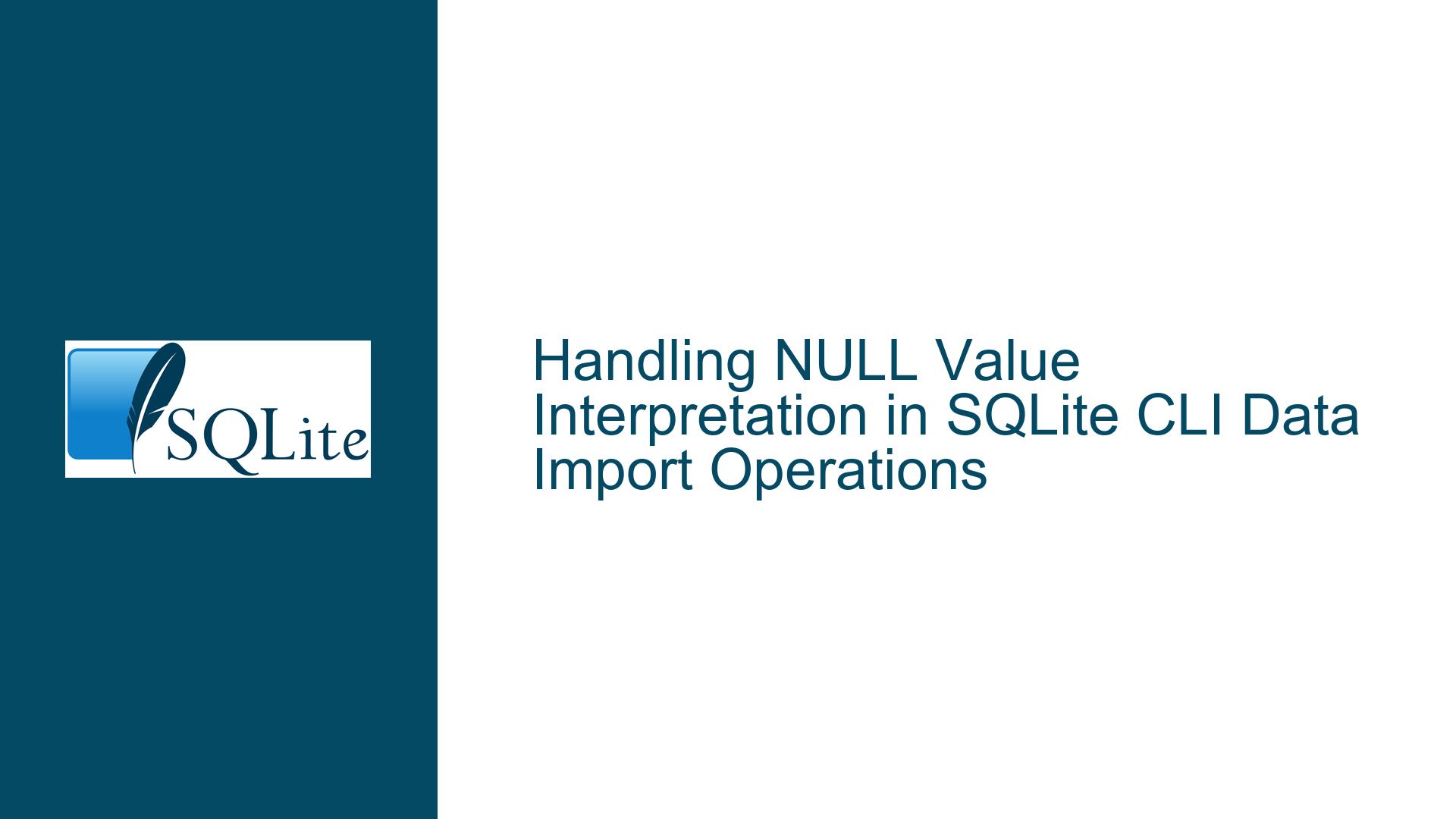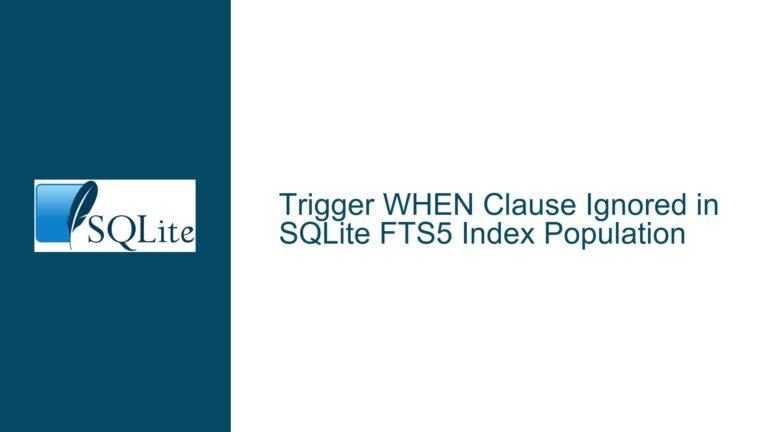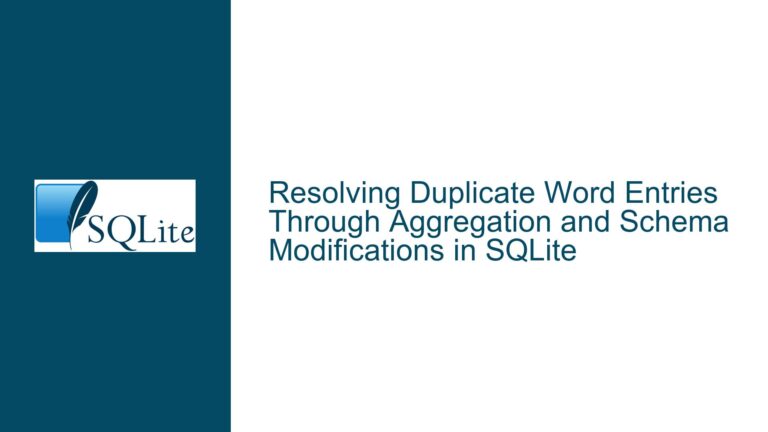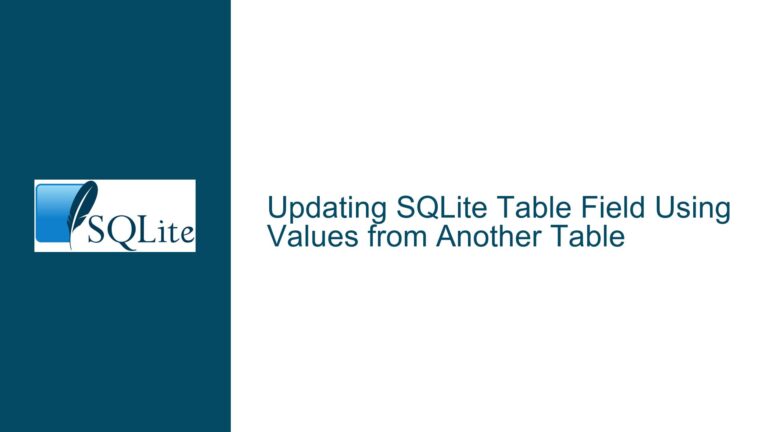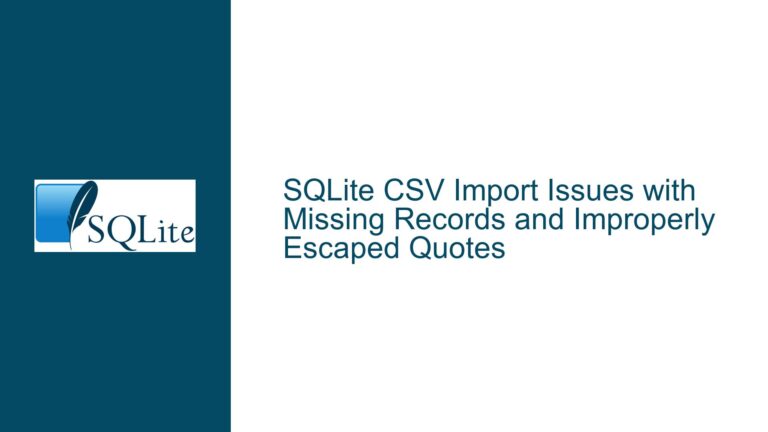Handling NULL Value Interpretation in SQLite CLI Data Import Operations
Understanding NULL Value Handling Discrepancies Between SQLite Export and Import
The SQLite command-line interface (CLI) provides robust data manipulation capabilities through meta-commands like .import for bulk loading and .mode for output formatting. A fundamental challenge arises when attempting round-trip operations where:
- Exported NULL values are represented using the
.nullvalueconfiguration - Subsequent re-importation preserves these NULL representations as literal strings rather than database NULLs
This discrepancy manifests when using the standard workflow:
sqlite3 test.db ".mode csv" ".nullvalue NULL" \
"CREATE TABLE t(id INT, name TEXT); INSERT INTO t VALUES(1,NULL);" \
".output data.csv" "SELECT * FROM t;" ".exit"
sqlite3 test.db ".mode csv" ".import data.csv t" \
"SELECT quote(name) FROM t;" # Returns 'NULL' as string instead of NULL
The core issue stems from .import treating all input values as literals without interpreting configured null representations. This breaks data fidelity in scenarios requiring:
- Backup/restore operations preserving NULL semantics
- ETL pipelines moving data between SQLite instances
- Cross-database migrations using CSV intermediates
Philosophical and Technical Constraints of Bulk Import Design
Three primary factors contribute to this behavior:
1. Minimalist CLI Design Philosophy
The SQLite project maintains strict adherence to the Unix philosophy of small, focused utilities. The .import command intentionally avoids value transformation logic to:
- Keep code complexity manageable (current implementation: ~150 LOC)
- Maintain predictable performance characteristics
- Reduce maintenance burden for edge cases
- Avoid feature creep into ETL tool territory
2. Separation of Concerns Implementation
Current architecture separates:
- Physical ingestion (file parsing, column separation)
- Logical interpretation (type conversion, null handling)
- Data transformation (value cleansing, normalization)
This design expects users to handle logical interpretation through subsequent SQL operations:
-- Standard workaround using staging table
CREATE TEMP TABLE staging AS SELECT * FROM t WHERE 0;
.import data.csv staging
INSERT INTO main.t SELECT
id,
CASE WHEN name = 'NULL' THEN NULL ELSE name END
FROM staging;
3. Asymmetric NULL Handling in Input/Output
While output formatting respects .nullvalue:
.mode list
.nullvalue 🐕
SELECT NULL; -- Outputs 🐕
Input processing lacks equivalent configuration, creating impedance mismatch:
Exported value: 🐕 → Re-imported as: '🐕' (TEXT)
Implementing NULL-Aware Data Import Strategies
Workaround 1: Two-Phase Import With Temporary Staging
Step 1: Create Mirror Schema
Create staging table matching target structure:
-- Preserve original schema automatically
CREATE TEMP TABLE import_staging AS
SELECT * FROM main.target_table WHERE 0;
Step 2: Raw Data Import
Import CSV/TSV without transformation:
.import --csv data.csv import_staging
Step 3: NULL Transformation Query
Convert null markers during final insert:
-- Dynamic NULL conversion using current .nullvalue
INSERT INTO main.target_table
SELECT * REPLACE(
CASE column1 WHEN (SELECT value FROM pragma_null_value) THEN NULL ELSE column1 END,
CASE column2 WHEN (SELECT value FROM pragma_null_value) THEN NULL ELSE column2 END
) FROM import_staging;
Advantages
- Works with all SQLite versions ≥3.8.0
- Allows per-column transformation logic
- Enables data validation before final commit
Disadvantages
- Requires manual schema synchronization
- Needs explicit column mapping for REPLACE()
- Double storage requirement for large datasets
Workaround 2: SQLite Virtual Table Integration
Leverage the csv virtual table for NULL-aware parsing:
Step 1: Load CSV Extension
Enable CSV virtual table (if not built-in):
.load /usr/lib/sqlite3/extensions/csv.so
Step 2: Create CSV Virtual Table
Define null marker during table creation:
CREATE VIRTUAL TABLE temp.csv_data USING csv(
data = 'data.csv',
header = true,
null = 'NULL' -- Matches .nullvalue setting
);
Step 3: Import to Target Table
Insert with automatic NULL conversion:
INSERT INTO main.target_table SELECT * FROM temp.csv_data;
Advantages
- Native NULL interpretation during parsing
- Supports complex CSV dialects
- No intermediate table management
Disadvantages
- Requires CSV extension compilation/loading
- Limited to CSV format (no TSV/ASCII)
- Additional memory overhead
Workaround 3: Preprocessing With External Tools
Use stream editors to convert null markers before import:
Using GNU sed:
# Convert 'NULL' strings to empty fields
sed -E 's/(^|,)\yNULL\y(,|$)/\1\\N\2/g' data.csv | \
sqlite3 test.db ".import --csv '|cat -' target_table"
Using Python Pandas:
import sqlite3
import pandas as pd
df = pd.read_csv('data.csv', keep_default_na=False, na_values=['NULL'])
with sqlite3.connect('test.db') as conn:
df.to_sql('target_table', conn, if_exists='append', index=False)
Advantages
- Handles complex file formats
- Works with any SQLite CLI version
- Enables advanced data cleansing
Disadvantages
- Introduces external dependencies
- Requires data pipeline redesign
- Potential performance overhead
Evaluating the –nulls Patch Proposal
The proposed code modification introduces:
// Modified CLI logic in src/shell.c
if( sCtx.zNullValue!=0 && cli_strcmp(z,sCtx.zNullValue)==0 ){
sqlite3_bind_null(pStmt, i+1);
}else{
sqlite3_bind_text(pStmt, i+1, z, -1, SQLITE_TRANSIENT);
}
Technical Merits
Round-Trip Consistency
Matches NULL representation in export/import cycles:.nullvalue NULL .export data.csv .import --nulls data.csvBackward Compatibility
Opt-in via--nullsflag preserves existing behaviorMinimal Performance Impact
Single string comparison per field
Implementation Risks
Ambiguous Null Markers
Accidental matching of valid data strings to.nullvalueType Affinity Conflicts
Potential issues withTEXTcolumns containing.nullvaluestringsExtension Compatibility
Possible conflicts with third-party CLI extensions
Comparative Analysis With Other RDBMS
| Database | NULL Handling in Import | Default NULL Marker | Customization |
|---|---|---|---|
| SQLite | Requires post-processing | N/A | Proposed via –nulls |
| MySQL | LOAD DATA INFILE NULL= | \N | User-definable |
| PostgreSQL | COPY ... NULL AS | \N | User-definable |
| Oracle | SQL*Loader NULLIF clause | Empty string | Column-specific |
Recommended Best Practices
For Current SQLite Versions (≤3.45.0)
Adopt Staging Tables
Implement two-phase import with explicit NULL conversion:-- Using JSON1 extension for dynamic null conversion INSERT INTO final_table SELECT json_extract(value, '$[0]') AS col1, CASE json_extract(value, '$[1]') WHEN (SELECT value FROM pragma_null_value) THEN NULL ELSE json_extract(value, '$[1]') END AS col2 FROM ( SELECT json_array(`csv_col1`, `csv_col2`) AS value FROM staging_table );Leverage CHECK Constraints
Prevent accidental storage of null marker strings:CREATE TABLE sensitive_data ( id INTEGER PRIMARY KEY, sensitive_text TEXT CHECK( sensitive_text != (SELECT value FROM pragma_null_value) ) );Implement View-Based Sanitization
Create sanitized views over raw imported data:CREATE VIEW clean_data AS SELECT id, CASE WHEN name = .nullvalue THEN NULL ELSE name END AS name FROM raw_import;
If Adopting the –nulls Patch
Validation Protocol
- Verify null marker uniqueness in source data
-- Pre-import check for ambiguous null markers SELECT COUNT(*) FROM ( SELECT * FROM target_table WHERE some_column = (SELECT value FROM pragma_null_value) );Import Workflow Standardization
# Sample safe import procedure sqlite3 db.sqlite3 \ ".nullvalue @NULL@" \ ".import --nulls --csv data.csv staging" \ "DELETE FROM staging WHERE rowid=1;" # Remove headerMonitoring and Logging
Track null conversions during import:-- Create import audit table CREATE TABLE import_audit ( import_time TIMESTAMP DEFAULT CURRENT_TIMESTAMP, null_count INTEGER, source_file TEXT ); -- Log null conversions INSERT INTO import_audit (null_count, source_file) SELECT SUM( CASE WHEN col1 IS NULL THEN 1 ELSE 0 END + CASE WHEN col2 IS NULL THEN 1 ELSE 0 END ), 'data.csv' FROM staging;
Future-Proofing Strategies
SQLite Configuration Layer
Propose extended configuration framework:PRAGMA import_null_value = 'NULL'; -- Separate from output nullvalueEnhanced Import Modes
Develop mode-specific null handling:.mode csv -nulls .import data.csv # Auto-enables null conversionExtension API Hooks
Allow custom null handlers via loadable extensions:sqlite3_import_handler_register( "null_converter", my_null_converter_func, user_data );
This comprehensive analysis demonstrates that while current SQLite versions require workarounds for NULL preservation during import, the proposed –nulls patch offers a balanced compromise between CLI simplicity and real-world data handling needs. Users requiring immediate resolution should implement staging table strategies while monitoring SQLite release notes for potential adoption of this enhancement.
